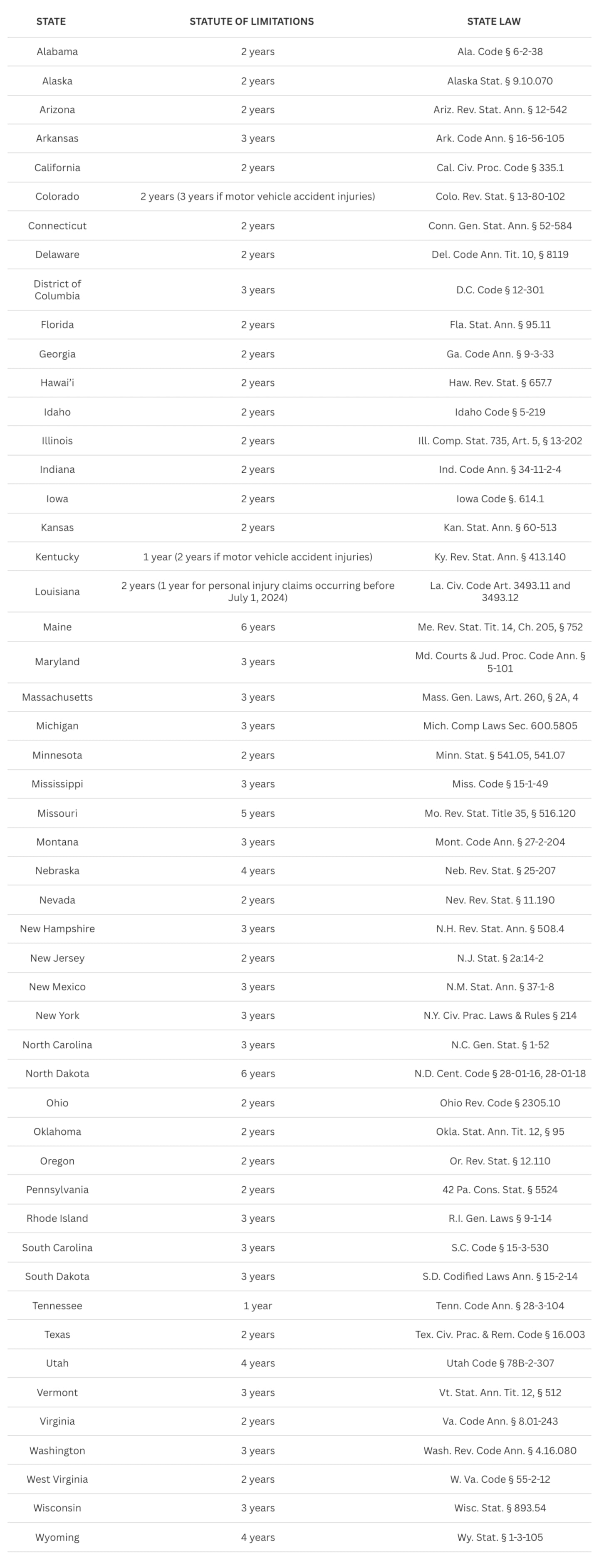Personal injury statute of limitations: How long you have to file in every state
Imagine getting seriously hurt in a car accident and then finding out two years later that it's too late to file a claim. It happens more often than you'd think. Many people don't realize there's a hard deadline to take legal action, and once it passes, so does your chance at compensation.
Every state sets a legal deadline, called the statute of limitations, for filing personal injury lawsuits. Miss that window, and you may lose your right to seek damages entirely. But here's the catch—these deadlines vary. Some states give you six years. Others? Just one.
THE702FIRM Injury Attorneys breaks it all down below, discussing the statute of limitations in every state, explaining exceptions like the discovery rule and tolling, and showing how real-world cases hinge on timing. Whether you're in the middle of a claim or just want to stay informed, knowing your state's deadline could make or break your case.
Why do personal injury deadlines exist in the first place?
Statutes of limitations are time limits that make sure legal claims are filed while the facts are still fresh. Once too much time passes, evidence can disappear, and memories fade. That's why the clock starts ticking the day the injury happens.
There's a balance at play. Defendants shouldn't face the threat of lawsuits years down the line, and injured people deserve a clear window to take action. Courts want these cases handled while they're still grounded in current, reliable information, not hazy details from years ago.
The difference between filing and settling
One common myth is that starting settlement talks buys you more time, but it doesn't. The statute of limitations is only about the deadline to file a lawsuit, not when you report the injury or talk to an insurance company. You could be deep in negotiation and still lose your right to sue if the deadline passes.
Fairness for both sides
These laws aim to strike a fair balance. They protect defendants from endless legal risk while giving victims a firm timeline to act. While the deadlines vary by state, the idea behind them stays the same: make the legal process predictable, fair, and timely for everyone involved.
How much time do you really have? Here's what each state allows
One of the easiest mistakes an injury victim can make is assuming they have more time than they do. The truth is that the deadline to file a personal injury lawsuit varies dramatically depending on where you live. Miss it, and your right to recover damages—no matter how valid your case—could be gone for good.
Here's a state-by-state guide to quickly look up your state's statute of limitations, along with the relevant legal code:
THE702FIRM Injury Attorneys
What do the numbers say?
Looking at state laws, some patterns stand out:
- 28 states give you 2 years to file most personal injury claims.
- 12 states allow 3 years, giving a bit more breathing room.
- 5 states use a more complex setup, with limits ranging from 1 to 6 years depending on the injury or who's involved.
These differences matter. If you're injured in Tennessee, you might have just one year to act. But in Maine, you could have up to six. And the type of case matters, too. Injuries involving government agencies, car accidents, or specific types of harm can all come with different rules, even within the same state.
When the clock pauses: Key exceptions to filing deadlines
Statutes of limitations may sound like hard deadlines, but in some cases, the law gives injured people more time. These exceptions can extend or pause the countdown, buying you critical breathing room if your injury isn't immediately obvious or unique circumstances apply. Knowing how they work could be the difference between a dismissed case and a valid claim.
The discovery rule: When you don't know you're injured—yet
Not every injury is immediate. Some harm only shows up later, and that's where the discovery rule comes in. It delays the statute of limitations until the injured person knew or reasonably should have known about the injury.
Some real-world examples include:
- Long-term exposure to harmful chemicals that take years to cause symptoms.
- A surgical error that was only revealed during a later procedure.
- A medical misdiagnosis that worsened before it was caught.
Whether your state allows the discovery rule depends on the situation. Some states apply it broadly, while others restrict it to certain case types, like medical malpractice. The discovery rule exists because fairness demands some flexibility, especially when injuries are hidden or delayed.
Tolling provisions: When time legally stops
Tolling is another way the statute of limitations can pause. It applies in specific legal situations where the clock either stops ticking or never starts until certain conditions are met.
Two common scenarios:
- The injured person is a minor. Most states pause the statute of limitations until the person turns 18. After that, there's usually a 1–2 year grace period to file. In Shalabi v. City of Fontana, a minor successfully filed years later because California law paused the deadline until he turned 20.
- The defendant disappears or hides. If the person responsible skips town, hides their identity, or dodges legal service, the deadline often pauses. For example, California's CCP § 351 tolls the clock until the defendant is located or returns to the state.
Exceptions exist, but get confirmation
These exceptions exist to keep the process fair, but they're not automatic. You'll need to prove they apply to your case. That's why it's smart to talk to a legal expert early on, especially if you're unsure about deadlines or think an exception might apply.
How minors are protected: Tolling rules by state
Kids can't always act on their own after an injury, and the law recognizes that. Most states pause the statute of limitations for minors until they turn 18. However, the exact rules vary by state and by case type, especially when medical malpractice is involved.
How 4 major states handle minor injury claims
California
- Standard rule: The clock stops until the child turns 18. After that, they have 2 years to file, so the final deadline is their 20th birthday.
- Medical malpractice: For birth injury cases, specifically, the claim must be filed within one year of the child's birth.
Texas
- Standard rule: Tolling applies until age 18, with 2 years to file after, making the deadline the child's 20th birthday.
- Medical malpractice: No tolling here. Parents must act within the normal statute of limitations on the child's behalf (2 years).
New York
- Standard rule: Minors have 3 years from when they turn 18 to sue for personal injury, making their 21st birthday the filing deadline.
- Medical malpractice: There's a hard 10-year cap, meaning you must file within 10 years of the date of the malpractice, no matter the child's age at the time of injury.
Nevada
- Standard rule: Tolling applies until age 18, with 2 additional years to file after turning 18; the deadline is the child's 20th birthday.
- Medical malpractice: For most cases, the statute is not tolled for minors. Claims must be filed within 3 years of the injury or 1 year after discovery, whichever is sooner. For cases involving brain damage or birth defects, the deadline is extended until the child's 10th birthday. In cases of sterility, the claim must be filed within 2 years of discovery.
What else is there to know when a child is injured?
Bringing a claim for a child also comes with extra legal steps to protect their rights, including:
- Guardian ad litem. Courts usually appoint a parent or legal guardian to represent the child in court formally.
- Court approval of settlements. Any settlement involving a minor typically needs a judge's sign-off to ensure it's fair and in the child's best interest.
These protections are essential, but they also make it even more important to work with an attorney who knows how these rules play out. One missed step or misunderstood exception could mean losing the chance to recover damages.
What happens if you miss the deadline?
When the statute of limitations runs out, so does your legal right to file a personal injury claim. It doesn't matter how strong your case is or how solid the evidence is, courts rarely make exceptions. Here are three common outcomes:
1. Your case gets tossed. No trial, no exceptions.
Courts don't bend on deadlines. If you file even one day late, the defendant can ask for a dismissal, and in most cases, the judge has to grant it. There's no trial, no chance to explain, and no appeal unless a very narrow exception applies. Filing outside the statute of limitations usually means your case is permanently barred. It's over before it starts.
2. Your negotiating power disappears.
Even if you never planned to go to court, missing the legal deadline still hurts you. Once your right to sue is gone, insurance companies know they're off the hook. They'll often stop negotiating (or offer a lowball amount) because they know you can't legally force a payout. This is where many victims get stuck. They may still be injured and need help, but without the legal leverage, they're out of options.
3. You lose the chance to settle, no matter how valid your case is.
Unlike criminal cases, personal injury claims don't come with grace periods. Once the statute expires, there's no legal obligation for anyone to consider your claim. Most insurance policies won't cover late-filed cases either.
That means even clear-cut cases with serious injuries or obvious fault can't move forward. No court, no settlement, no second chance.
How to protect your personal injury claim: A 4-step checklist
Here's a simple four-step checklist to help you stay on track and preserve your right to compensation:
1. Document everything right after the injury
Start gathering proof as soon as the incident happens. Take photos, get contact info from witnesses, and see a doctor immediately. Detailed records from day one can make or break your case.
2. Confirm your state's deadline
Every state sets its own filing window, usually one to six years. But that timeline can shift depending on the type of injury, who's involved, or if a government agency is part of the case. It's critical to lock in your deadline early to avoid costly surprises.
3. Check for exceptions that pause the clock
Some situations may give you extra time. If you were a minor when injured or only discovered the harm later, tolling provisions might apply. But the rules vary by state, and they're not always straightforward. A legal expert can help you sort it out.
4. Lock down your evidence before you file
Make sure all your key evidence is secure before filing. Keep digital and physical records organized, avoid altering anything, and request official reports like police or incident records. Preserved evidence makes your claim stronger and harder for the defense to challenge.
Miss the Deadline, Miss Your Case: Don’t Risk It
The filing deadline for personal injury claims isn't the same everywhere. Some states give you just one year (like Tennessee), while others offer up to six (like Maine or North Dakota). Nevada, including Las Vegas, sets a two-year statute of limitations for most personal injury cases, meaning you generally have two years from the date of your injury to file a lawsuit. That wide range makes it crucial to know your state's rules and to act fast after an injury.
One thing is consistent: your right to compensation is usually gone once the deadline passes. Waiting too long can lead to automatic dismissal, lost negotiation power, and no legal options, even if your case is solid. That's why talking to a personal injury lawyer early matters. They can explain your state's deadline, check for any tolling exceptions, and help protect your right to file before time runs out.
The window to act isn't open forever. Identify your deadline, make a plan, and give yourself the best chance to recover what you're owed.
This story was produced by THE702FIRM Injury Attorneys and reviewed and distributed by Stacker.










